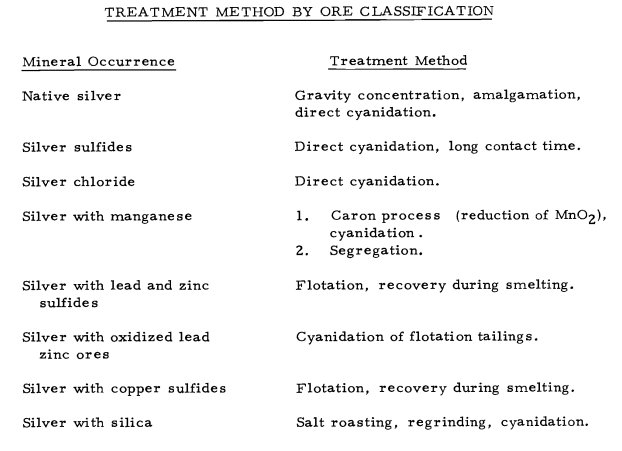Ecological controls of tailing storage pond effluents are mainly concerned with mercury and residual cyanide and are critical problems for gold and silver recovery plant operators. For example, mercury for direct amalgamation of gold ore was used at Homestake until 1970 when the Federal Government acted to prevent further use thereby forcing the abandonment of this practice. However, mercury is still used at Homestake, in South Africa, and also in some Philippine and Canadian cyanide plants for barrel amalgamation of free gold gravity concentrates. The amount of mercury involved in South African practice is about 150 ounces for every 100, 000 tons of ore milled and which reaches the tailings ponds. In South Africa, it is obligatory that no pond effluent be discharged beyond the mining property boundaries and waters containing mercury and cyanide must be evaporated either on the tailings pond or in specially constructed evaporation dams.
In some cyanide plants such as Carlin and Cortez in the United States, all supernatant solution from the tailings ponds are returned to the plant for reuse. When all solution cannot be reused, the excess may be evaporated in shallow ponds, or by spray systems inside of the tailings dam. Such plant reuse of tailings effluent depends strictly upon the degree of contamination or "fouling" of the barren solution and tailing water with cyanicides. Foul solutions that cannot be returned from the tailings pond may be effectively cleaned up by cyanide regeneration. Cyanogens in plant solutions exist chiefly as free alkali cyanides, as zinc and copper double cyanides, as sulphocyanides, and as ferrocyanides. From the free cyanides and zinc double cyanides, substantially complete recovery of the cyanogen is easily effected. Part of the cyanogen combined with copper is also recovered; regeneration of the remainder with the cyanogen existing as sulphocyanide and ferrocyanides requires special treatment. At this stage, it would be generally more practical to eliminate the remaining cyanogen by chlorination.
Ecologists have also been concerned with pollution of ground waters from cyanidation plant tailings. An accute problem is solution seepage down stream from tailings dams and strict attention to prevent or collect any seepage is a real necessity.
The tolerance levels of the total cyanide content in potable water set by several U. S. and State health agencies are 10 ppb, and 20 ppb discharged into ground waters. The cyanide content so established is, strangely enough, based on the survival tolerance of fingerling trout. Decanted waste water from tailings dams may be effectively treated by the use of alkaline chlorination for the purpose of destroying all cyanide compounds. The alkaline hypochlorite used to oxidize the cyanide to cyanate is applied as such or generated within the waste solution by adding caustic (NaOH) and chlorine gas. A second chemical reaction involves complete destruction of the sodium cyanate.
In some cyanide plants such as Carlin and Cortez in the United States, all supernatant solution from the tailings ponds are returned to the plant for reuse. When all solution cannot be reused, the excess may be evaporated in shallow ponds, or by spray systems inside of the tailings dam. Such plant reuse of tailings effluent depends strictly upon the degree of contamination or "fouling" of the barren solution and tailing water with cyanicides. Foul solutions that cannot be returned from the tailings pond may be effectively cleaned up by cyanide regeneration. Cyanogens in plant solutions exist chiefly as free alkali cyanides, as zinc and copper double cyanides, as sulphocyanides, and as ferrocyanides. From the free cyanides and zinc double cyanides, substantially complete recovery of the cyanogen is easily effected. Part of the cyanogen combined with copper is also recovered; regeneration of the remainder with the cyanogen existing as sulphocyanide and ferrocyanides requires special treatment. At this stage, it would be generally more practical to eliminate the remaining cyanogen by chlorination.
Ecologists have also been concerned with pollution of ground waters from cyanidation plant tailings. An accute problem is solution seepage down stream from tailings dams and strict attention to prevent or collect any seepage is a real necessity.
The tolerance levels of the total cyanide content in potable water set by several U. S. and State health agencies are 10 ppb, and 20 ppb discharged into ground waters. The cyanide content so established is, strangely enough, based on the survival tolerance of fingerling trout. Decanted waste water from tailings dams may be effectively treated by the use of alkaline chlorination for the purpose of destroying all cyanide compounds. The alkaline hypochlorite used to oxidize the cyanide to cyanate is applied as such or generated within the waste solution by adding caustic (NaOH) and chlorine gas. A second chemical reaction involves complete destruction of the sodium cyanate.

 RSS Feed
RSS Feed
